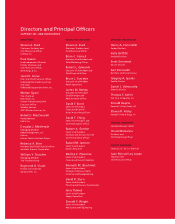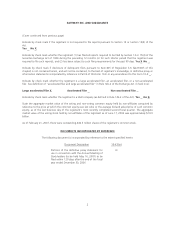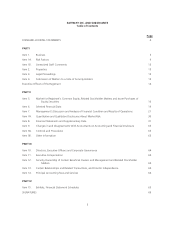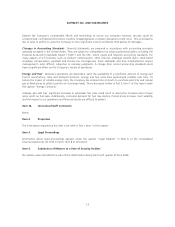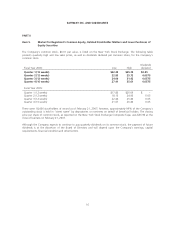Safeway 2006 Annual Report Download - page 28
Download and view the complete annual report
Please find page 28 of the 2006 Safeway annual report below. You can navigate through the pages in the report by either clicking on the pages listed below, or by using the keyword search tool below to find specific information within the annual report.SAFEWAY INC. AND SUBSIDIARIES
attract our customers to their stores by aggressively matching or exceeding what we offer. In recent years many of our
competitors have increased their presence in our markets. Our responses to competitive pressure, such as additional
promotions and increased advertising, could adversely affect our profitability. We cannot assure that our actions will
succeed in gaining or maintaining market share. Additionally, we cannot predict how our customers will react to the
entrance of certain non-traditional competitors into the grocery retailing business.
Because we face intense competition, we must anticipate and quickly respond to changing consumer demands more
effectively than our competitors. We must achieve and maintain favorable recognition of our unique and exclusive
private-label brands, effectively market our products to consumers in several diverse market segments, competitively
price our products, and maintain and enhance a perception of value for consumers. Finally, we must source and
market our merchandise efficiently and creatively. Failure to accomplish these objectives could impair our ability to
compete successfully and adversely affect our growth and profitability.
Labor Relations A significant majority of our employees are unionized, and our relationship with unions, including
labor disputes or work stoppages, could have an adverse impact on our financial results.
We are a party to approximately 400 collective bargaining agreements, of which 85 are scheduled to expire in 2007.
These expiring agreements cover approximately 37% of our union-affiliated employees. In future negotiations with
labor unions, we expect that rising health care, pension and employee benefit costs, among other issues, will be
important topics for negotiation. If, upon the expiration of such collective bargaining agreements, we are unable to
negotiate acceptable contracts with labor unions, it could result in strikes by the affected workers and thereby
significantly disrupt our operations. Further, if we are unable to control health care and pension costs provided for in
the collective bargaining agreements, we may experience increased operating costs and an adverse impact on future
results of operations.
Profit Margins Profit margins in the grocery retail industry are very narrow. In order to increase or maintain our
profit margins, we develop strategies to reduce costs, such as productivity improvements, shrink reduction, distribution
center efficiencies and other similar strategies. Our failure to achieve forecasted cost reductions might have a material
adverse effect on our business. Changes in our product mix also may negatively affect certain financial measures. For
example, we continue to add supermarket fuel centers, which generate low profit margins but significant sales.
Although this negatively affects our gross profit margin, fuel sales provide a positive effect on operating and
administrative expense as a percent of sales.
Opening and Remodeling Stores Our inability to open and remodel stores as planned could have a material
adverse effect on our results. In 2007 we anticipate opening approximately 25 Lifestyle stores while completing
approximately 275 Lifestyle remodels. If, as a result of labor relations issues, supply issues or environmental and real
estate delays, these capital projects do not stay within the time and financial budgets we have forecasted, our future
financial performance could be materially adversely affected. Furthermore, we cannot ensure that the new or
remodeled stores will achieve anticipated same-store sales or profit levels.
The Growth of Blackhawk Blackhawk’s business, financial condition, results of operations and prospects are
subject to certain risks and uncertainties. Consequently, actual results could differ materially from Blackhawk’s
targeted earnings growth. There is no assurance that Blackhawk will continue to grow at the same rate as it has in the
past. Some of the specific risks and uncertainties include, but are not limited to, the following:
• Blackhawk faces competition from other companies that may introduce new products that compete with
products offered by Blackhawk. This could limit Blackhawk’s future growth;
• Blackhawk is substantially dependent on the continuous operation and security of its information technology
applications and infrastructure;
• Blackhawk is substantially dependent on its management team, and the loss of any key member of
management could impede Blackhawk from executing its business strategy;
• A significant portion of Blackhawk’s revenues and net earnings is realized during the last several weeks of the
calendar year and are related to consumer gift purchases. A reduction in consumer spending for gifts,
10


